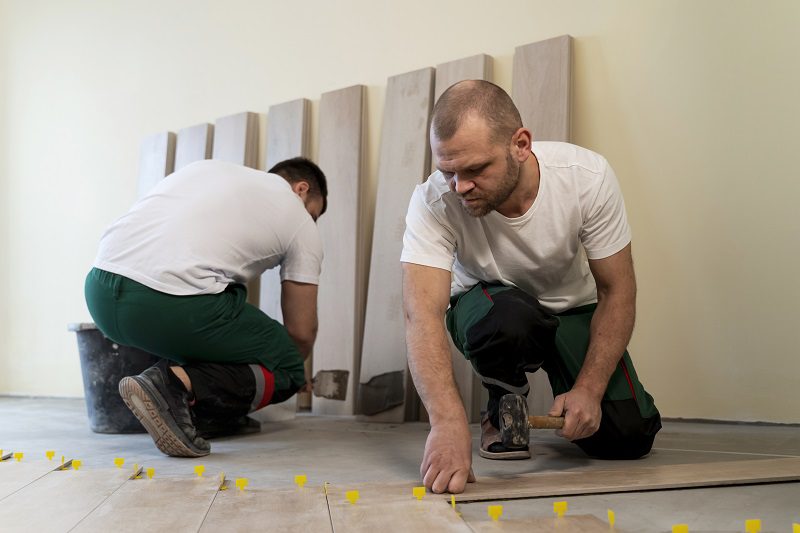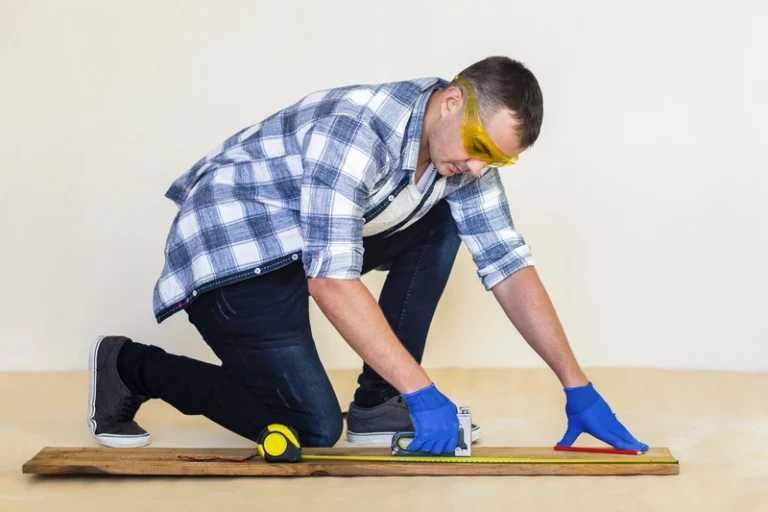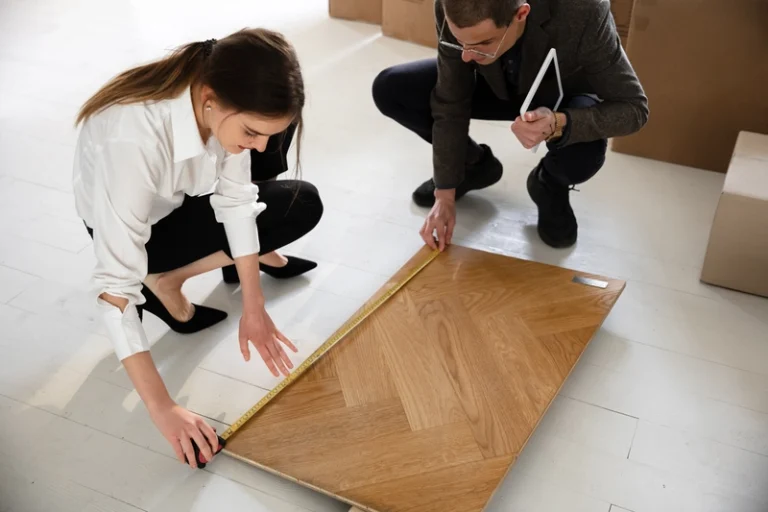How to fix laminate flooring that is lifting? This common problem can be caused by moisture damage, improper installation, or subfloor issues. We will explore what causes laminate flooring to lift and provide you with practical solutions on how to prevent and fix them.
From acclimating the flooring to using adhesive to reattach lifting planks, we’ve got you covered. Learn when it might be time to seek professional help for your laminate flooring troubles.
Reasons for Laminate Flooring Lifting
Why does laminate flooring lift? Laminate flooring can warp and lift due to various factors. Understanding why your laminate floor is lifting is crucial to implementing effective solutions.
One common reason for laminate flooring warping and lifting is moisture damage. Improper installation techniques can also lead to laminate flooring issues. Inadequate acclimatisation of the planks before installation, using the wrong underlay, or failing to leave expansion gaps around the edges can all contribute to warping and lifting.
Subfloor problems, such as uneven surfaces or moisture issues beneath the laminate, can cause the flooring to lift and become unstable over time. Addressing these root causes is essential for maintaining the integrity and longevity of your laminate floors.
a. Moisture Damage
Moisture damage is a significant cause of laminate flooring lifting, especially at the edges where water can seep in and weaken the material.
When water infiltrates through the edges of laminate flooring, it can wreak havoc on the integrity of the entire structure. The presence of moisture leads to swelling of the fibreboard core, causing the planks to warp and lift. This bulging not only compromises the aesthetic appeal of the flooring but also poses safety risks, as the uneven surface can cause tripping hazards.
Effective moisture barriers can help prevent such issues by blocking water infiltration at the edges and safeguarding the core material from absorbing excess moisture. Once water seepage occurs, prompt action is essential to minimise damage and prevent further lifting or separation of the laminate planks.
b. Improper Installation
Improper installation of laminate flooring can cause it to lift over time, creating gaps and uneven surfaces that pose a tripping hazard.
These gaps not only affect the aesthetic appeal of your floor but also compromise its structural integrity. As the flooring lifts, it can lead to further damage and even potential safety risks.
Fixing lifting floors is possible with timely intervention. One solution is to carefully remove the affected planks and reinstall them correctly to eliminate the gaps.
Preventing future warping involves ensuring the subfloor is level and dry before installation, using proper underlayment, and allowing for proper expansion gaps during installation.
c. Subfloor Issues
Subfloor issues, such as uneven surfaces or inadequate support, can lead to laminate flooring raising or lifting, disrupting the integrity of the installation.
When the subfloor is not properly prepared, it can create a host of problems for your laminate flooring. Uneven surfaces create gaps between the floor and the subfloor, leading to an unstable foundation for the laminate. This lack of stability can result in the flooring panels lifting, bulging, or even cracking over time.
One common reason for subfloor-related lifting is inadequate support. Without adequate support, the laminate flooring may not be able to distribute weight evenly, leading to localised pressure points that can cause the flooring to lift.
How to Prevent Laminate Flooring from Warping and Lifting
Preventing laminate flooring from warping and lifting requires proactive measures to safeguard against moisture damage, improper installation, and subfloor issues.
One key preventive strategy is to acclimatise the laminate flooring in the room where it will be installed before laying it down. Using a high-quality moisture barrier beneath the flooring can help block any moisture from seeping through and causing damage to the laminate.
Following correct installation techniques, such as leaving proper expansion gaps and ensuring a flat, level subfloor, is crucial for preventing issues like lifting and buckling.
Taking these preventative measures can help maintain the integrity and longevity of your laminate flooring.
a. Acclimatise the Flooring
Properly acclimatising laminate flooring before installation is essential to prevent issues like lifting or buckling, ensuring a stable and durable floor surface.
When laminate flooring is exposed to a new environment, it needs time to adjust to the temperature and humidity levels. Without this adjustment period, the planks can expand or contract, leading to gaps, lifting, or warping over time. By acclimatising the laminate flooring, you allow it to reach moisture equilibrium with the surroundings, reducing the risk of these common installation problems.
b. Use a Moisture Barrier
Installing a damp-proof membrane beneath laminate flooring can safeguard against water damage, reducing the risk of warping or lifting over time.
Damp-proof membranes are essential components in ensuring the longevity and durability of laminate flooring. By acting as a shield against moisture seepage, these barriers create a protective layer that prevents water intrusion, a common cause of damage to laminate floors. Without this precaution, moisture can penetrate the flooring material, leading to swelling, warping, or even mould growth.
Damp-proof membranes not only protect the flooring itself but also contribute to maintaining a healthy indoor environment. They help to prevent issues like bacteria growth and odours caused by water damage, enhancing the overall quality of the living space. Investing in a quality damp-proof membrane can save you from costly repairs and replacements in the long run, making it a smart choice for any homeowner looking to preserve their laminate flooring.
c. Follow Proper Installation Techniques
Adhering to correct installation techniques is crucial in preventing laminate flooring from coming up or lifting, ensuring a secure and long-lasting installation.
One fundamental step in achieving a successful laminate flooring installation is preparing the subfloor properly. This involves ensuring the subfloor is clean, level, and dry before laying down the underlayment. Proper acclimatisation of the flooring materials to room temperature is also essential to prevent warping or buckling post-installation. Using the right tools and following manufacturer guidelines for expansion gaps and room layout play a significant role in the overall longevity of the flooring. By meticulously adhering to these steps, you can avoid common issues like floor popping or shifting over time.
How to Fix Laminate Flooring that Is Lifting
Addressing laminate flooring that is lifting requires identifying the root cause of the issue and implementing appropriate solutions to restore the floor’s stability.
How to stop laminate flooring from lifting? When fixing laminate flooring popping up, one must first examine the area to determine if the problem lies with the subfloor or the planks themselves.
Inspecting the subfloor for any unevenness, moisture, or damage is crucial in understanding why the laminate is lifting. Once the cause is pinpointed, the next step involves repairing subfloor issues, which could range from levelling the surface to replacing damaged sections.
Replacing the damaged planks with new ones that match the rest of the flooring is essential for a seamless fix. In some cases, adding adhesive or re-installing the planks may be necessary to ensure a secure fit and prevent future lifting.
1. Identify the Cause of Lifting
Before proceeding with repairs, it is crucial to pinpoint the exact cause of the laminate flooring lifting, whether it be due to moisture, installation, or other factors.
Identifying the root issue behind laminate flooring lifting is like solving a puzzle; each piece holds a clue to the overall picture. This detective work not only ensures that the repairs are effective but also prevents recurring problems. For instance, if moisture infiltration is the culprit, addressing waterproofing may be the key. If poor installation is to blame, adjustments in that area will be necessary. Each cause demands a specific remedy, making a targeted approach crucial for successful repairs.
2. Fix Subfloor Issues
Addressing subfloor issues is essential in fixing laminate flooring that is bowing or lifting, as the subfloor provides the foundation for the flooring installation.
In terms of laminate flooring, issues with the subfloor can cause a domino effect of problems throughout the entire installation. A stable subfloor is crucial for ensuring that the laminate flooring remains flat and secure. Without addressing subfloor imperfections, even the highest quality laminate flooring may encounter issues such as creaking, uneven surfaces, or premature damage.
By rectifying subfloor problems before laying down laminate flooring, homeowners can not only enhance the durability and lifespan of their floors but also improve the overall aesthetic appeal of their living space.
3. Replace Damaged Planks
Damaged planks in laminate flooring must be promptly replaced to prevent further issues like popping up or bulging, maintaining the floor’s aesthetics and functionality.
Here are the step-by-step instructions to effectively replace damaged planks in laminate flooring:
- Start by identifying the damaged plank or planks that are causing the issue.
- Use a flat tool like a putty knife to carefully lift the damaged plank and remove it from the floor.
- Inspect the exposed area to ensure there is no damage to the subfloor.
- Measure the dimensions of the removed plank to cut a replacement piece to the exact size.
- Carefully insert the new plank into place, ensuring it fits snugly with the surrounding planks.
- Apply a suitable adhesive according to manufacturer instructions to secure the new plank in place.
- Gently tap the replacement plank with a mallet to ensure it is level with the rest of the floor.
- Allow the adhesive to dry completely before walking on the repaired area.
4. Use adhesive to reattach lifting planks.
Applying suitable adhesive to reattach lifting planks can help stabilise the flooring and prevent further lifting or separation, ensuring a seamless and secure floor surface.
When dealing with laminate flooring, it’s crucial to address any lifting planks promptly to maintain the integrity of the entire floor.
By using the right adhesive, you can effectively secure the loose planks back in place. This method not only fixes the immediate issue of lifting but also provides reinforcement against potential expansion or popping up of other planks. The adhesive creates a durable bond, allowing the planks to remain firmly adhered to the subfloor, minimising the risk of future problems.
5. Use a Weighted Object to Hold Down Lifting Planks
Using a weighted object to hold down lifting planks temporarily can help flatten the flooring while the adhesive sets, promoting a secure and even surface.
When dealing with laminate flooring, movement or plank lifting can be a common issue, often caused by improper installation or environmental factors. By placing a weighted object over the affected area, you can ensure the planks stay in place and adhere properly during the crucial setting time. This simple yet effective technique can prevent future problems such as gaps or unevenness in the flooring, providing a stable and aesthetically pleasing result.
When to Seek Professional Help for Laminate Flooring Issues?
In certain scenarios, it may be necessary to enlist professional assistance for laminate flooring issues, especially when the damage is extensive or the cause is challenging to determine.
Professional help becomes crucial when the complexity of the issue surpasses what you can handle independently. Even if you think you have identified the cause of the problem, the intricacies of laminate flooring can sometimes lead to hidden issues that only a trained eye can detect.
Professional flooring experts possess specialised tools and equipment that are vital in diagnosing and fixing intricate problems effectively. Their experience allows them to address issues efficiently, minimising the risk of further damage or wrong repairs.
a. Extensive Damage
If your laminate flooring exhibits extensive damage such as severe warping, bulging, or widespread lifting, it is recommended to consult professionals for a comprehensive restoration.
Professional intervention becomes crucial when faced with significant issues like severe damage to laminate flooring. These problems, including warping, bulging, or extensive lifting, can indicate underlying structural issues that require expert assessment. Proper evaluation by specialists helps determine the extent of the damage and the best course of action for effective repairs.
b. Inability to Identify the Cause of Lifting
If you are unable to pinpoint the exact cause of your laminate flooring issues, such as unexpected raising or lifting, seeking professional help can provide valuable insights and solutions.
Professional assistance plays a crucial role in identifying the underlying reasons behind lifting in laminate flooring. Experienced flooring experts have the know-how to assess the situation accurately, considering factors like subfloor moisture levels, installation quality, or issues with the locking system.
By engaging skilled professionals, you can benefit from their specialised knowledge and diagnostic tools to determine the root cause of the problem effectively. This not only ensures a precise diagnosis but also paves the way for the most appropriate and lasting solutions to address the lifting issues.
c. Lack of Experience and Tools
If you lack the necessary experience or tools to address laminate flooring issues like bowing or expansion effectively, consulting professionals can ensure proper and lasting solutions.
Professional assistance is crucial when encountering problems with laminate flooring, as improper handling can lead to further damage and costly repairs. Expert guidance not only saves you time and effort but also guarantees a high-quality finish that enhances the longevity of your flooring.
By hiring skilled professionals, you benefit from their in-depth knowledge of flooring repair challenges and access to specialised tools, ensuring that the issues are diagnosed accurately and resolved efficiently. Trusting professionals for your laminate flooring needs can result in a durable and visually appealing floor that withstands the test of time.

See product: Quick-Step Classic Havana Oak Natural With Saw Cuts
In conclusion, dealing with laminate flooring that is lifting can be a challenging task. While DIY solutions might seem appealing, they often fall short in ensuring a long-lasting and flawless finish. For a professional and reliable solution, consider using a flooring installation service from TEKA Flooring.
Our expert team has the experience and skills to address any issues with your laminate flooring, ensuring it is properly fixed and restored to its original beauty. Don’t let lifting laminate disrupt your home’s comfort and aesthetics.
Contact TEKA Flooring today and let us provide you with the high-quality service you deserve!
Read also:














